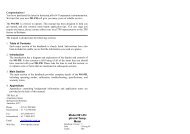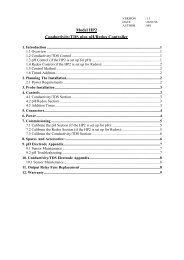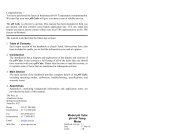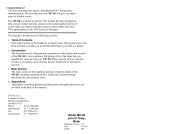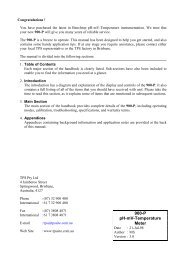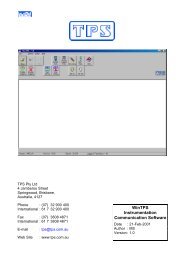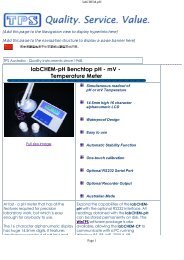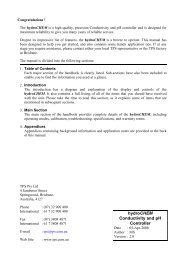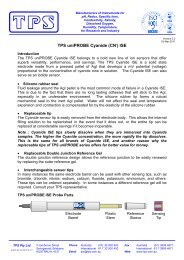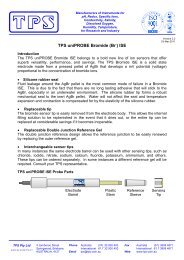900-C Conductivity, TDS, Resistivity, Ratio, Meter - TPS
900-C Conductivity, TDS, Resistivity, Ratio, Meter - TPS
900-C Conductivity, TDS, Resistivity, Ratio, Meter - TPS
You also want an ePaper? Increase the reach of your titles
YUMPU automatically turns print PDFs into web optimized ePapers that Google loves.
245.7 <strong>Resistivity</strong> CalibrationBefore attempting a <strong>Resistivity</strong> calibration, ensure that the <strong>900</strong>-C has been set up correctly,according to sections 5.1 to 5.6. The calibration procedure detailed below uses the sampleconfigurations shown in sections 5.1 to 5.6.Also ensure that Temperature has been correctly calibrated (see section 7.1). A “ ∗ ” in theTemperature readout in place of the decimal point indicates that Temperature is NOT calibrated.1. Plug the <strong>Resistivity</strong> sensor into the CELL socket and the temperature sensor into the TEMPsocket. (The separate temperature sensor is not required for combination<strong>Resistivity</strong>/Temperature sensors.)2. Rinse the <strong>Resistivity</strong> and temperature sensors in distilled water. Shake off as much water aspossible. Blot the outside of the sensor dry. DO NOT BLOT THE ELECTRODE PLATES.Air Calibration3. Let the sensor dry in air.4. Select <strong>Resistivity</strong> Calibration ( → F1:Calibrate → F1:<strong>Resistivity</strong>).5. The <strong>900</strong>-C will recognise the Over-range resistivity signal and attempt an Air calibration. Forexample…Over-range k=1*00 25.0 O cPress Enter to Zero probe or Menu Exit.6. When the reading has stabilised at the Over-range reading, press to calibrate or toquit. The ∗ will not be removed after an Air calibration.Standard Calibration7. Place the <strong>Resistivity</strong> sensor into a sample of <strong>Resistivity</strong> standard, so that it is immersedcorrectly, with adequate clearance to the floor and walls of the vessel. See section 17.2 fordetails of correct sensor immersion.DO NOT place the sensor directly into the bottle of standard. Discard the used sample ofstandard after use.Select <strong>Resistivity</strong> Calibration ( → F1:Calibrate → F1:<strong>Resistivity</strong>). Thecalibration screen will be displayed, with the <strong>Resistivity</strong> standard to be used. For example…362* Ω.cm k=1*00 25.0 O cPress Enter to Calibrate. STD=362.3Ω.cm.cm8. When the reading has stabilised, press to calibrate. The ∗ will now be replaced by adecimal point, if calibration was successful.9. The <strong>900</strong>-C is now calibrated for <strong>Resistivity</strong> and is ready for use in this mode.



